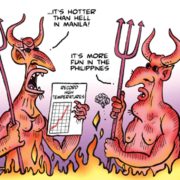THE Philippines is enjoying a steady economic momentum and has been branded as the next Asian tiger economy.
Last week, the United Nations Economic and Social Survey of Asia and the Pacific (UNESCAP) said in its latest survey that the local economy is expected to grow by 6.2 percent this year. The currency has been relatively strong. And remittances rose by six percent to $1.682 billion in February from $1.587 billion in the same period last year.
On Monday, April 22, the Philippine Stock Exchange index (PSEi) closed with an all-time high this year at 7,120.48 points. Buoyed by strong corporate earnings and a bullish economy, the Philippines’ main price index surpassed the elusive 7,000 for the first time.
Such achievement was broadly was broadly welcomed by ministers and industry leaders.
Presidential spokesperson Edwin Lacierda said that Monday’s achievement marks the 88th record high in 34 months of the Aquino administration, and the 27th record high this year.
“This stands as a manifestation of continued confidence in the prospects of our economy, not only from the international community, but also from Filipinos who are raising their stake in our country’s success,” Lacierda said in a statement.
Lacierda also stressed President Benigno Aquino’s unyielding leadership, in making sure that the momentum gained by the PSEi numbers will impact “the widest possible segment of society.”
“Empowering our people remains among the priorities of our government; we are committed to the vision of a truly dynamic citizenry that can take full advantage of the opportunities opening up in this era of national renewal,” he said.
This is a great feat, especially for a country once tagged as the “Sick Man of Asia.”
While this news is encouraging, millions of Filipinos would still beg to differ.
In its latest report, The National Statistical Coordination Board (NSCB) said that poverty incidence in the country has remained unchanged in the past six years.
The report declared 27.9 percent of the population showing poverty incidence, based on the data from the Family Income and Expenditure Survey (FIES) and conducted by the National Statistics Office (NSO) in July 2012.
“Comparing this with the 2006 and 2009 first semester figures estimated at 28.8 percent and 28.6 percent, respectively, poverty remained unchanged as the computed differences are not statistically significant,” NSCB Secretary General Jose Ramon Albert said in the report.
Albert said that the agency will deliver clearer and up-to-date poverty reports in the country more often rather than every three years.
He said this will help policy makers and stakeholders (from both the public and private sectors) to create informed programs based on timely and accurate statistics.
Before this tiger economy can fully roar, it must first aim for a more inclusive growth.
An economic growth is only inclusive when it creates equal access to the people it employs and creates opportunities for them.
As economists would put it, inclusive growth must allow people to contribute and benefit from the economic gains.
With an established economic momentum and well-endowed resources, it is now time to deliberate on the citizenry’s needs: stable job, sustainable income, access to basic service and an accountable government.
It is this booming economy’s responsibility to not just increase in numbers, but also make its presence felt by most Filipinos — before the next poverty incidence report shows up.
(AJPress)





